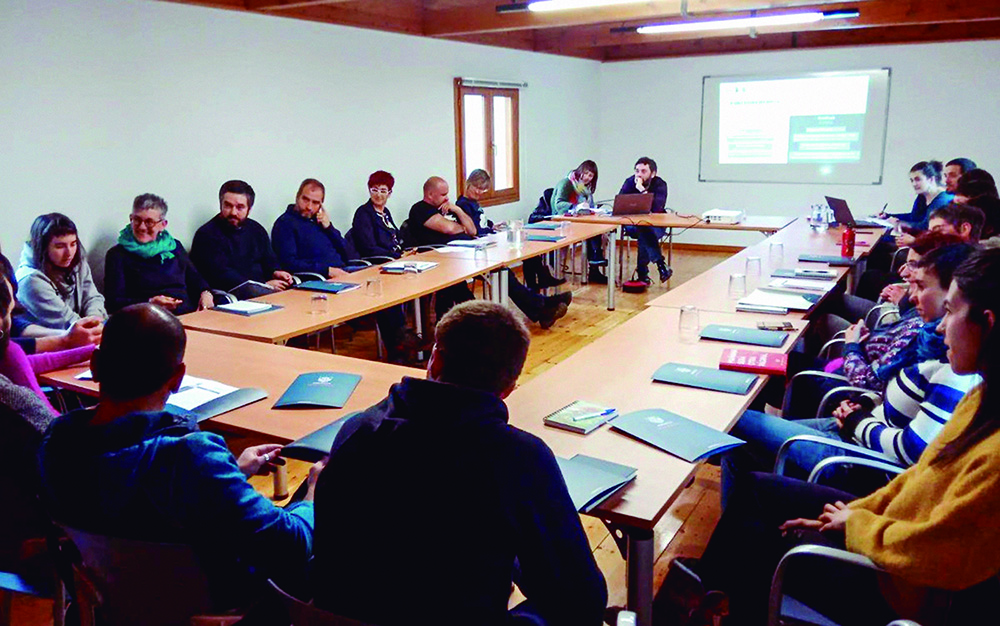In 45 localities in Alavesas, special attention is needed because of the serious risk of depopulation.
- More than three hundred localities have less than 200 inhabitants and eleven municipalities have less than ten inhabitants per square kilometre. The Member of Álava has presented the study carried out by the UPV/EHU on this matter.

According to the Spanish Association of Municipalities against Depopulation, municipalities that are below the limit of 200 inhabitants, in the medium term, are likely to disappear. In Álava, except Treviño, there would be 317 localities in this situation, according to a new demographic study presented by the University of the Basque Country. However, the deputy of Economic Development, Innovation and Demographic Challenge of the Provincial Council of Álava, Pilar García de Salazar, has denied the existence of this risk. "None of this has happened in Álava and we are convinced that it will not happen," said the General Deputy of Álava. According to the deputy, the characteristics of the territory and the work carried out in recent years show that "our demographic reality shows that Álava is different".
In the same vein, the Professor of Human Geography of the UPV/EHU María Cruz Porcal, who led the study of the UPV/EHU, has been expressed. "The case of Álava cannot be compared with the reality of evacuated Spain," said the foral MEP.
On behalf of the Provincial Council, the UPV/EHU has analyzed the decline of the population from the point of view of the 426 population groups that make up the Alavese territory, with the objective of depopulating and identifying the populations at risk of disappearance. They have used the substate scale to evidence the internal differences hidden in very large municipalities or quadrillas.
A total of 45 localities are at serious risk, particularly in the Mendialdea and Añana blocks, as well as in the peripheries of other gangs. They live 939 Alaveses. These include Etxabarri-Kuartango, Jokano, Atiaga, Vault, Acebedo, Guinea, Iñurrieta, Nograro, Marinda, Basquiñuelas or Basabe.
Local analysis by locality
In the presentation of the study, Mr. García de Salazar explained that the Deputy wanted to "detect the demographic evolution, the socioeconomic situation and the level of risk of each municipality to make detailed decisions and adjust its solutions to the measure of each municipality".
The professor at the UPV/EHU, for his part, has highlighted the "innovative" methodology he has used in the classrooms, with scales lower than the municipalities. Porcal has pointed out that it is difficult to establish a single type of risk of depopulation. "Many methodologies can be used and the topic is complex, even more so when you have to analyze 426 locations of very different characteristics," explained the mayor of Vitoria-Gasteiz. Therefore, the classification has been carried out according to a wide variety of criteria, taking into account a scale of importance among the risk factors, and using statistics from administrations have defined five categories, classifying risk populations as low and very high.
Thus, most of the Alavese municipalities – 28.87% – have placed themselves at a medium level of risk. In the very high risk there are 45 municipalities – 10.56% –, 109 municipalities at high risk – 25.59% – and 144 at low or very low risk. On the other hand, if the municipalities are taken into account, there are two who are at very serious risk: El Valle and Lagrán, together with four others at high risk: Kuartango, Valdegovía, Ribera Baja and Arraia Maeztu.
Low population density
Another risk factor highlighted by the researcher is demographic density. In 2019, eleven municipalities had fewer than ten inhabitants per square kilometer, of which five (Lagrán, Bernedo, Kuartango, Valdegovía and Peñacerryanair-Urizaharra) had fewer than five inhabitants per square kilometer. According to the European Union, an area is at risk of depopulation if its population is less than 12,5 inhabitants per square kilometre.
"Demographic balances are more representative than densities. In fact, the demographic decline of the last 20 years is not a general phenomenon, as it mainly affects small municipalities and smaller population areas. The municipalities that have suffered the most notable demographic decline are the older ones, so the loss of population is due to the loss of population more than to migration", explains the researcher of the UPV/EHU. In any case, the study finds that the downward trend between 2001 and 2019 has stagnated, focusing on the peripheral areas of Álava away from the capital.
Based on the results of the study, García de Salazar stressed that the Department of Economic Development of the Diputación is working on actions such as housing, economic promotion, rural taxation, infrastructure and transport or public services and basic services.
2014 eta 2020 urteen artean 350 biztanle galdu ditu Zuberoak (-%2.55). Galera handienak Maule, Barkoxe, Sohüta, Garindaine, Ligi, Mitikile, Atharratze, Bildoze, Altzai eta Montori herrietan izan dira. Haatik, zenbait herritan biztanle kopurua emeki goratzen ari da.
Azken biztanle kontaketaren arabera, Lapurdiko kostaldeko herri bakarra da Ziburu beheranzko joeran dagoena. 6.800 izatetik 6.200 biztanle izatera pasa da azken sei urteotan.
Hurrengo urtean India izango da munduko herrialderik populatuena, Txinaren aurretik; datorren azarorako, 8.000 milioi herritar izango ditu planetak; zortzi herrialdetan kontzentratuko da biztanleriaren hazkunderik handiena; baina oro har jaiotze tasa txikitzen eta biztanleria... [+]
From time to time, I hear or read a concern that normally goes through the edge of my attention: the population ages. It's happened to me recently. And through a plunge of data, I'm usually unearthed by the pace and geography of that aging. It tempts us to be serious and to... [+]
Herri eta bailara ugari basamortu bihurtzen ari da Euskal Herrian. Lan eta zerbitzurik gabe, egungo merkatuak bazterturiko eremuotan nola bizi? Egoera hori irauli nahi du Udalbiltzak, eta horretarako, logika lehiakorretik at, pertsonak erdigunean jartzen dituen ekonomia... [+]























